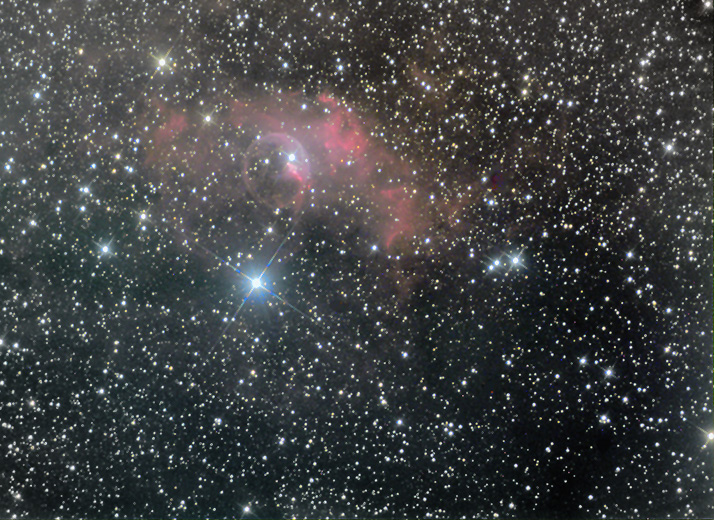11/11/2012. Has it been that long? After a six-month season of sungazing, I've slowly returned the RC to service under the night sky. The last two nights have been sparklers, and I've used them for sky-trials and to retune this and that. Collimation held up and focus needed only the slightest tweak. Polar alignment was durable! The A-P keypad continues to have its problems (a tale to be told soon) and the photos below were made using SkyWire and an iPod Touch to control the mount. It works, but the battery doesn't last. I've wired up the netbook to use PulseGuide tonight. That software did not seem particularly well suited to nudging the 'scope during sungazing, or else I needed more practice with it, but I think it will be luxurious under the deepsky. Not the least of its virtues will be the ability to park the 'scope without stumbling out half-asleep in the dawn to do so.

M33, 6x900s L (1h30m)
10" RC @ F4.8

NGC 7635 (The Bubble Nebula)
5x900s L (1h15m) crop

NGC 7635 (The Bubble Nebula)
8x900s L (2h00m)
2x300s RGB (30m)
There's a dark nebula snaking off to the lower right, surely an unilluminated portion of the cloud into which the Bubble is expanding. A lot more exposure is called for and I have just the outfit to get it. It's worth noting that the brightest star below the bubble is the only star in any of these photos that is visible to the unaided eye, and then just barely under the darkest of skies. There are lot of stars up there.
11/13/2012. I got your festival of lights right here. Here's 14, 900s exposures of the region near the Bubble. I was trying to bring out that dark nebula (snaking downward in the bottom center of this image). It's Lynd's Dark Nebula 1230 which is nicely shown here, in a DSLR photo I find profoundly humbling. I should rotate the field now that I see how it's oriented. The shot's coming along, but more exposure is (of course, as always) needed:

NGC 7635 & Environs
14x900s L (3h 30m)
Right-click and View Image for Larger Version
I started off with PulseGuide but ran into aiming difficulties. The keypad worked fine when I plugged it in and recalibrated on the star Caph. After that, I could slew around with the computer just fine. An hour in, I took time out for a 45min RGB series (nothing good came of that) and flats (much did). I used the delay stop feature in PulseGuide to park the telescope after the Bubble got too low to image. The CCD sequence continued. Here's a view of the north celestial pole: 1h 15m with motors off:

Why is the pole not centered in Park 3? Well, polar alignment could be off, but I don't think it's that far off (I was seeing tiny guiding errors of 0.24 pixels RMS all night in both axes). The tube and the optical axis may well be 15 minutes of arc out of square with the mount -- interesting but not a problem.
Except where noted, deep-sky photos are made with an SBIG ST2000XM CCD behind a 10-inch Astro-Tech Ritchey-Chretien carried on an Astro-Physics Mach1GTO. The CCD is equipped with Baader LRGB and 7nm H-a filters. The internal guide chip of the CCD most often keeps the OTA pointed in the right direction (I'll let you know when a Meade DSI and a separate OAG or guidescope takes its place). Camera control and guiding are handled by Maxim DL 5.12. The stock focuser on the AT10RC has been augmented with Robofocus 3.0.9 using adapters turned on the lathe downstairs. Maxim performs image calibration, alignment, and stacking; Photoshop CS4 and FocusMagic 3.0.2 take it from there. Gradient Xterminator by Russell Croman and Astronomy Tools by Noel Carboni see their share of work, too. Beginning in May 2013, PixInsight has taken over some of the heavy lifting for transfer function modification and deconvolution.
:: top ::